
12 minute read
NiobiCon Connectors: When Electricity and Water Do Mix
De-mated NiobiCon connectors (Courtesy of Northrop Grumman)
NIOBICON™ CONNECTORS WHEN ELECTRICITY AND WATER DO MIX
Advertisement
By Richie Enzmann – ROV Planet
All underwater connectors on the market are basically trying to make conventional electrical contacts used in air to be used underwater by keeping water away. For this purpose, other manufacturers have been using O-rings, seals, and oil, to keep the water from touching the electrical contacts, by using the same technology underwater that was used above water. Northrop Grumman took a different approach to this and the NiobiCon connectors were invented.
Jim Windgassen is the co-inventor of NiobiCon and an engineer at Northrop Grumman in Annapolis, Maryland. Several years ago, Windgassen worked on a proposal effort that involved recharging autonomous underwater vehicles (AUVs) using inductive charging which was very cumbersome. The inductive charger occupied a lot of space inside the vehicle, and it wasn’t that efficient. Windgassen, frustrated by the limitations of inductive charging, started going down a different path and talked to a colleague, friend and co-inventor, Harvey Hack, who had done some work with connectors in the past using niobium, but purely for its corrosion resistance characteristics. When Hack mentioned niobium, this made Windgassen think about how an electrical device called a tantalum capacitor works, and that was the inspiration for NiobiCon. Hack, Windgassen and a third inventor, Jeff Matejka, also an engineer at Northrop Grumman, fabricated a crude working prototype and tested it. It worked surprisingly well, so they got a small amount of internal funding and made it into a more professional design that they demonstrated. During one of their demonstrations, they met Keith Johanns who had recently been hired to commercialize technologies from Northrop Grumman. Hack and Windgassen had been struggling on their own trying to advance this technology; Johanns was the missing piece of the team and this project has really blossomed since.
PHYSICAL PRINCIPLES AND CONNECTOR DESIGN
So, what is NiobiCon? It’s a novel way of achieving underwater wet-mate connections that leverage the material properties of transition metals, which include metals such as tantalum,

niobium, titanium, etc. You can mate and de-mate this connector underwater while it’s powered; in fact, you can reach inside and touch the contacts after you have de-mated it and it won’t shock you. The connectors operate in a flooded state all the time; seawater or other liquids surround the contacts while in operation.
How do the connectors work? The contacts were fabricated out of solid niobium metal. After the contacts are incorporated into the connector, it goes through an anodizing process, similarly to the way tantalum capacitors are made to grow an initial layer of oxide. This oxide layer is approximately 150nm thick, which is about the same as one wavelength of ultraviolet-C light. When the connector is mated, you get localized disruption of the oxide and metal to metal contact allowing current to flow. As soon as the connectors are de-mated those very small areas re-grow the oxide within milliseconds and reinsulate themselves. The oxide layer is an extremely good insulator, and keeps leakage currents down to micro amp levels. As with any type of underwater connector, the area where copper wires from the cable transition to the niobium contacts must be insulated from the environment. Northrop Grumman has used polyurethane and epoxy resins for potting this area in our connectors; glass-to-metal seals are also possible with niobium.

There are several connector designs that Northrop Grumman has fabricated. In the case of the demonstration kit that was constructed, 48VDC power was transferred with Radio Frequency (RF) superimposed on top to send Ethernet traffic across while transmitting power. Standard power line Ethernet adaptors identical to what you would use in your home to do Ethernet across the mains wiring of a home are used to do this.
It is possible to send data across NiobiCon through conventional communications protocols such as RS-422 / RS-485 or by superimposing RF on top of power as previously mentioned. In addition to sending data over the contacts directly, Northrop Grumman has also recently been granted a patent for combining NiobiCon for power along with active free space optical transceivers in a common connector to achieve very high data rates of 5-10 Gbps per channel. The active free space optical transceivers allow for a very robust and dirt / contamination tolerant data connection which is much more forgiving than traditional optical fiber connectors.
CHARGING OF AUVS
Another interesting application is a high-power connector that was designed to simulate charging an AUV. This is achieved using a coaxial design high-power connector. Imagine an AUV with a probe at the front which approaches an underwater docking station. The AUV enters the docking station and stabs its connector into the docking station’s connector to complete the connection process and charge itself and transfer data. Northrop Grumman demonstrated, the ability to transfer 55 amperes at 50 volts while simultaneously sending RF data across it using power line to Ethernet converters.
Coaxial High Power AUV Charging & Data Transfer Demonstration Connector (Courtesy of Northrop Grumman)
An advantage of coaxial connectors for an AUV application is that you don’t have to axially align the connector, allowing a simple stab operation in order to mate. This connector demonstrates the charging at power levels that you would need for a medium to large size AUV at 2.75 kilowatts. The current of 55 amperes was limited by the 6AWG cable attached to the connector. NiobiCon connectors can operate at any current level by properly designing the contacts.
SINGLE CONTACT WITH “SEAWATER RETURN”
An application combining NiobiCon technology with a “Seawater Return” has also been demonstrated. A seawater return uses seawater as a conductor to provide a return path for current in lieu of another wire. Seawater returns have been done for many years, but when you combine NiobiCon with it, you can have a single contact connector with a long exposed area such as a rod or wire that you can simply connect to. In this demonstration, the power supply’s positive terminal is connected to a niobium rod approximately 200mm long, and then the negative terminal of that power supply is connected to a graphite rod. Both of these rods are immersed in a fish tank filled with artificial seawater. The oxide layer on the niobium rod provides the insulation to prevent current flow in the water between the (+) niobium rod and the (-) graphite rod.
A handheld surrogate vehicle was used for this demonstration. Inside the vehicle there is a 12V LED light bulb as a demonstration load. At the front there is a V shaped yoke made of niobium and at the rear, there is a short graphite rod. The anode of the LED bulb is connected to the niobium yoke, and the cathode of the LED bulb is connected to the graphite rod at the back of the vehicle. As soon as the vehicle’s yoke touches the niobium rod, it makes electrical contact after the thin oxide layer of the niobium is displaced during mating. This allows current to flow through the LED bulb inside the vehicle, then out the graphite rod into the seawater, and then finally back to the power supply through the graphite rod connected to the power supply. With this solution you can do single contact connections underwater anywhere.

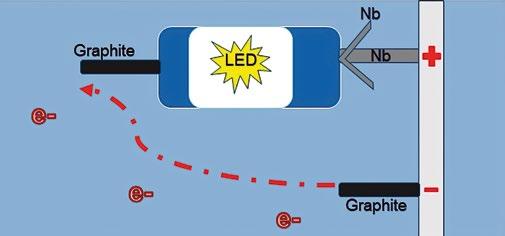
NiobiCon Combined With Seawater Return Demonstration (Courtesy of Northrop Grumman)
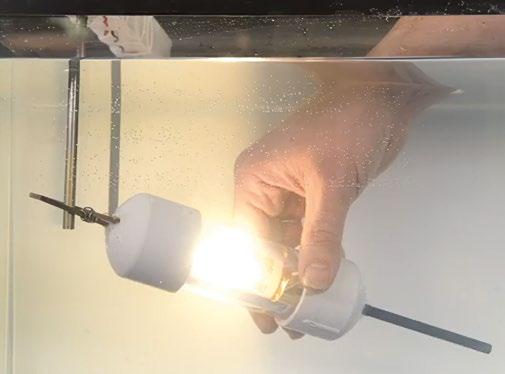
This combination of NiobiCon and seawater return allows for some interesting applications. For example, you could have a niobium wire stretching through the water and just by clipping onto the wire anywhere along its length, power will be accessible. If you had LED lights, you could just clip them onto this wire and have light wherever needed.
NiobiCon technology gives you a lot of design freedom that you wouldn’t have doing such things any other way. The same exposed niobium rod or wire in the water can also support seawater exposed dynamic sliding contact applications.
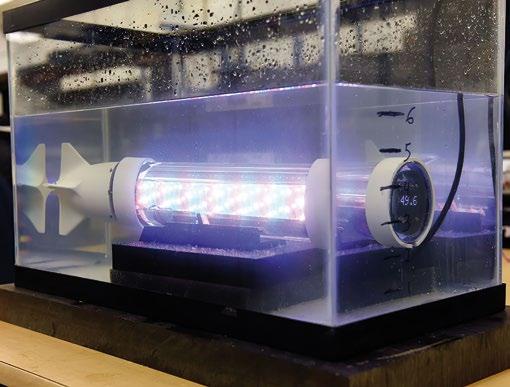
DIFFERENT CONNECTOR STYLES
Depicted below is a commercial style connector made two years ago by Northrop Grumman’s first manufacturing licensee, iCONN Systems, LLC. This connector is an M12 style connector. This has been used to demonstrate communications with a small remotely operated vehicle (ROV), as the tether cable connector.
M12 Style Connector Manufactured by iCONN Systems, LLC (Courtesy of Northrop Grumman)
Another type of connector is the prototype USB connector. The contacts inside were actually made out of niobium earring wire. Niobium as a material is very safe and has no toxicity, so it’s used in biomedical applications because it’s hypoallergenic. With this connector, you can plug it in and watch videos underwater.

Another demonstration is an AUV proxy which is demonstrated in a fish tank filled with artificial seawater. This demonstration consists of two parts, a simulated docking station and a model AUV. The docking station consists of a plate with two horizontal niobium rails approximately 18cm long on it which are attached to a 48 volt DC power supply. Our AUV consists of a clear acrylic tube with curved niobium contacts on the underside that follow the curvature of the tube. Inside the tube is a voltage display, and an Arduino connected to some addressable RGB LEDs. When the AUV is set down upon the rails, power transfer begins, the incoming voltage is displayed, and an underwater animated light show begins. You can reach into the fish tank and touch the niobium rails with your fingers and not get shocked, yet the oxide is thin enough that simply setting the AUV onto the rails is sufficient to establish a connection. The purpose of this demonstration is both to show the ease with which an AUV can be charged underwater as well as to demonstrate the design freedom that NiobiCon technology has to offer for making underwater connections.
AUV Open Rail Underwater Charging Demonstration (Courtesy of Northrop Grumman)
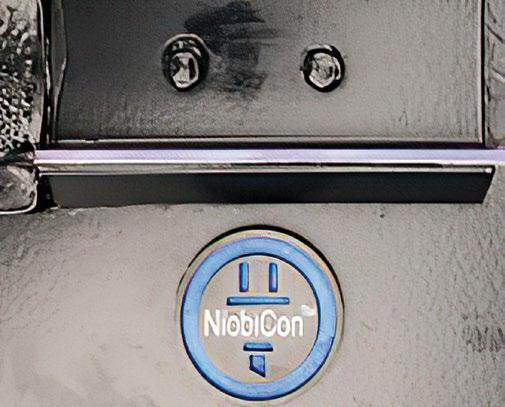

ADVANTAGES AND DISADVANTAGES OF THIS TECHNOLOGY
The advantages of this technology are that it’s simpler than inductive charging or conventional underwater connectors with seals. No large, complex electronics are involved as with inductive power transfer, and NiobiCon is much smaller and more efficient than an inductive solution. There are no seals, no O-rings, no oil and nearly an infinite number of mating cycles on these connectors. The very first connector made years ago, has been mated over 1,500 times and still looks the same as the day it was made. NiobiCon connectors have very low mating forces and can be designed for very loose alignment tolerances unlike many conventional wet-mate connectors which require precise alignment and high mating forces. In addition, this technology has a level of intrinsic safety built into it. You can touch the contacts with your fingers underwater and you won’t get shocked and it will not deliver current into the water if left open while powered. Connectors based on this technology lower maintenance and enhance reliability immensely as you don’t have to worry about replacing seals, or damaged O-rings. If you de-mate this connector while it’s powered, you don’t have to turn off the power first as with conventional connectors. With conventional underwater connectors if you take them apart while powered, you will short out the connectors and corrode the contacts rapidly. With NiobiCon you can reimagine or reinvent how underwater connectors can be designed. For example, you could swap a removable battery pack underwater just as you would in air. It provides for a very simple design – which can effectively lower costs. As long as your cable can withstand the pressure, there is no intrinsic depth limit to this technology because it’s a solid metal.
This technology is a good solution for up to 60-75VDC. The film that is on the niobium breaks down at about 120VDC. At present, these connectors are not directly capable of handling AC power due to the reversing polarity disrupting
In this test the NiobiCon connectors used on a BlueROV as tether connectors (Courtesy of Northrop Grumman)
the oxide layer formation. Northrop Grumman has received two patents for addressing the AC power and voltage limitation issues and are conducting research into other means of improving this technology. One unusual thing about these connectors when you put them together and want to measure the resistance of that connection, particularly when dry, there is a low voltage varistor-like effect. If you try to use a common digital multi-meter to measure the resistance of the connection, you will get erroneous results. In order to measure the resistance / voltage drop across the connector, a constant current source and a voltmeter must be used.
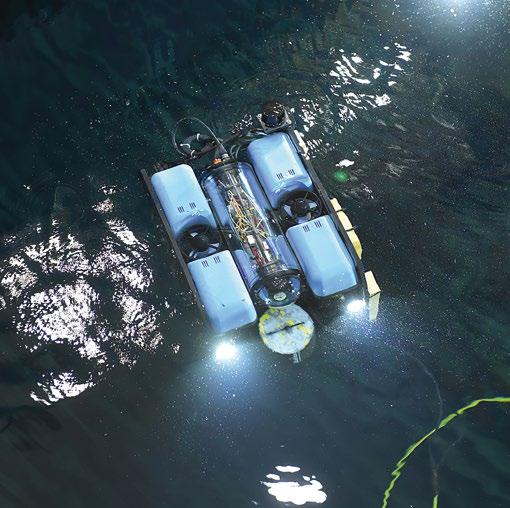
Finally, the cost of niobium metal is about 10 times the cost of copper but usually the copper is not the driving factor in the overall cost of connectors; particularly underwater connectors. The cost difference of the niobium vs. copper can easily be made up by the simplification of the design of the rest of the connector which is devoid of sealing features.
LICENSING AND FUTURE PLANS
Northrop Grumman is not a connector company, which is driving its commercialization strategy to non-exclusively license this technology out to connector manufacturers and other interested parties. Currently, Northrop Grumman has granted a non-exclusive manufacturing license to iCONN Systems, LLC, located in Lombard, IL. There are also organizations interested in developing their own connectors. For example, Monterey Bay Aquarium Research Institute (MBARI) is another licensee with a plan to recharge their long range AUVs underwater that are utilized in deep-ocean scientific research. Their primary interest is to develop this technology specifically for their platforms. If your company or organization is interested in licensing the technology directly, please get in touch with the Northrop Grumman NiobiCon team. The team has a website which has several videos, information, and contact information on it. If you are interested in directly purchasing NiobiCon based design solutions, please reach out to iCONN Systems, LLC. iCONN Systems LLC’s website devoted to the NiobiCon technology is here:







